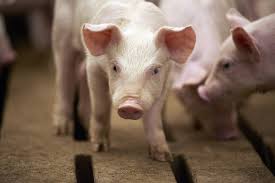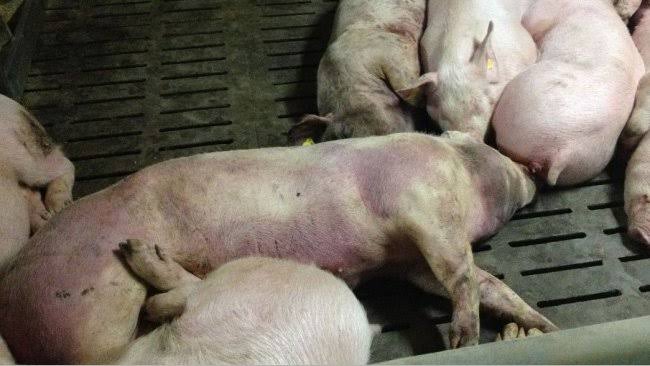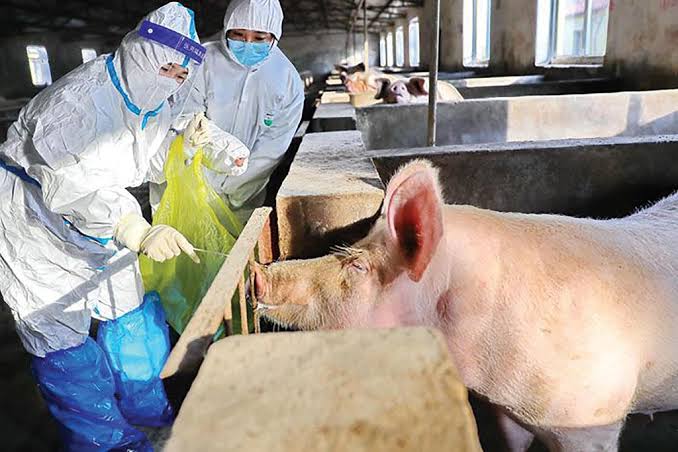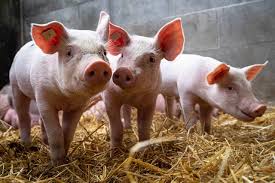African Swine Fever, scientifically known as African swine fever virus (ASFV), is a highly contagious viral disease affecting domestic and wild pigs. This virus can cause severe illness in swine populations, leading to significant economic losses for farmers and impacting the food supply chain.
The ASFV is not harmful to humans but poses a substantial threat to pigs. It spreads through direct contact with infected animals, contaminated feed, or even through ticks that carry the virus. Once a pig is infected, the disease can progress rapidly, with symptoms ranging from high fever and loss of appetite to severe internal bleeding and death.
Efforts to control African Swine Fever involve strict biosecurity measures on farms, such as disinfection, restricting movement of pigs, and proper disposal of infected carcasses. Unfortunately, there is currently no specific treatment or vaccine available, making prevention crucial in managing the spread of the virus.
The impact of African Swine Fever extends beyond individual farms, affecting entire regions and countries. Outbreaks can disrupt pork production, leading to shortages and increased prices for pork products. Furthermore, culling infected and at-risk pig populations becomes a necessary but challenging measure to contain the disease.
International collaboration is essential in combating African Swine Fever, as the virus does not recognize borders. Countries around the world work together to share information, implement control measures, and conduct research aimed at developing effective vaccines.
African Swine Fever is a serious viral disease with far-reaching consequences for the pig farming industry. Vigilant biosecurity measures and international cooperation are crucial in managing and preventing the spread of this contagious virus, ultimately safeguarding both pig populations and the economic stability of the pork industry.
Read Also: Reproduction and Management Practices in Snail Business
Animals Affected by African Swine Fever (ASFV)

African Swine Fever primarily affects domestic and wild pigs. Domestic pigs, including those on farms, are particularly susceptible to the virus. The disease can spread rapidly within pig populations, leading to significant morbidity and mortality.
Wild boars are also highly vulnerable to African Swine Fever. The virus can have a devastating impact on wild pig populations, affecting ecosystems and wildlife dynamics. The transmission between domestic pigs and wild boars is a concern, contributing to the persistence and spread of the disease.
Although African Swine Fever does not directly harm humans, its impact on pig populations has indirect consequences for the human food supply. Pork is a significant source of protein for many communities, and outbreaks of this disease can result in a decrease in pork production, leading to shortages and increased prices for pork products.
Efforts to control the spread of African Swine Fever often involve culling infected pigs and implementing biosecurity measures on both domestic pig farms and in areas where wild boars roam. These measures aim to limit the transmission of the virus and prevent further outbreaks.
African Swine Fever primarily affects domestic and wild pigs, posing challenges for the agricultural industry and impacting ecosystems where wild boars reside. The interconnectedness between domestic and wild pig populations underscores the importance of comprehensive strategies to control and prevent the spread of this highly contagious viral disease.
Damages Caused by African Swine Fever

African Swine Fever inflicts substantial damages on the pig farming industry and the broader economy. The impacts include economic losses, disruptions in food supply chains, and ecological consequences.
1. Economic Losses: Outbreaks of African Swine Fever can lead to significant economic losses for the pig farming industry. Infected pigs may suffer high mortality rates, reducing the overall production of pork. This, in turn, affects farmers’ income and can lead to financial instability within the agricultural sector.
2. Trade Restrictions: The presence of African Swine Fever in a region often triggers trade restrictions on pork and related products. Export bans are imposed by countries to prevent the spread of the virus, further impacting the economic viability of pork producers who rely on international markets.
3. Culling and Depopulation: To control the spread of the virus, authorities may implement culling measures, involving the mass euthanasia of infected and at-risk pigs. This process not only results in the loss of valuable livestock but also poses ethical and emotional challenges for farmers who must depopulate their herds.
4. Food Shortages: As pork production declines due to African Swine Fever outbreaks, there is a potential for shortages in pork products. This can lead to increased prices for pork and pork-related items, affecting consumers and contributing to food insecurity in some regions.
5. Ecological Impact: The disease can also have ecological consequences, especially when it affects wild pig populations. African Swine Fever outbreaks in wild boars can disrupt natural ecosystems, influencing predator-prey relationships and overall biodiversity.
6. Investment in Prevention and Control: Governments and agricultural stakeholders must invest significant resources in prevention and control measures, including biosecurity infrastructure, research, and public awareness campaigns. These expenses contribute to the overall economic burden associated with the disease.
African Swine Fever causes a range of damages, encompassing economic losses for the pig farming industry, disruptions in international trade, potential food shortages, ethical challenges associated with culling, and ecological impacts on wild pig populations and ecosystems. The comprehensive consequences highlight the need for effective strategies to prevent, control, and manage outbreaks of this highly contagious viral disease.
Read Also: Sourcing, Selection and Stocking of Snails
Control and Preventive Measures

Controlling and preventing the spread of African Swine Fever (ASF) involves a combination of strict measures aimed at reducing the risk of introduction, detecting and managing outbreaks, and implementing biosecurity protocols. Here are key control and preventive measures:
1. Biosecurity Practices: Implementing robust biosecurity measures on pig farms is crucial. This includes controlling access to farms, ensuring proper sanitation, and establishing protocols for visitors to minimize the risk of introducing the virus.
2. Surveillance and Early Detection: Regular monitoring and surveillance for ASF are essential for early detection. Rapid identification of infected animals allows for swift containment measures, reducing the potential for the virus to spread further.
3. Quarantine and Movement Restrictions: Infected or at-risk animals should be isolated and quarantined to prevent the spread of ASF. Movement restrictions on pigs within and between regions help contain the virus and reduce the risk of transmission.
4. Culling and Depopulation: In the event of an outbreak, culling infected and potentially exposed pigs is a common strategy to prevent the further spread of the virus. This is a challenging but necessary measure to contain the disease.
5. Tick Control: Since ticks can transmit ASF, controlling tick populations in pig habitats is important. This involves using acaricides and other tick control methods to reduce the risk of transmission.
6. Public Awareness and Education: Educating pig farmers, veterinarians, and the public about ASF is crucial. Promoting awareness about the signs of the disease, biosecurity practices, and the importance of reporting suspected cases can contribute to early detection and prevention.
7. Wildlife Management: Given the susceptibility of wild boars to ASF, managing and monitoring wild pig populations is essential. This may include targeted surveillance, habitat management, and other measures to reduce the risk of wild boars spreading the virus to domestic pigs.
8. International Collaboration: ASF knows no borders, and international cooperation is vital. Countries should collaborate on information sharing, research, and the development of control strategies to address the global nature of the disease.
9. Vaccine Development: Research into developing effective vaccines for ASF is ongoing. While there is currently no widely accepted vaccine, progress in this area could significantly enhance preventive measures in the future.
However, a multifaceted approach involving stringent biosecurity, surveillance, movement restrictions, culling when necessary, and international collaboration is crucial in controlling and preventing the spread of African Swine Fever. Ongoing research and advancements in vaccine development offer hope for more effective preventive measures in the future.
Frequently Asked Questions (FAQs) About African Swine Fever
Q1: What is African Swine Fever (ASF)?
A: African Swine Fever is a highly contagious viral disease affecting domestic and wild pigs. It can lead to severe illness, high mortality rates, and significant economic losses in the pig farming industry.
Q2: Can humans get African Swine Fever?
A: No, African Swine Fever does not affect humans. It is a disease specifically impacting pigs and wild boars. However, it can have indirect consequences on human food supply and the economy.
Q3: How is African Swine Fever transmitted?
A: ASF is primarily transmitted through direct contact between infected and healthy pigs, contaminated feed, and, in some cases, by ticks that carry the virus. Strict biosecurity measures are crucial in preventing transmission.
Q4: What are the symptoms of African Swine Fever in pigs?
A: Symptoms can vary but may include high fever, loss of appetite, lethargy, and in severe cases, internal bleeding. Infected pigs may die rapidly, and the disease can have a high mortality rate.
Q5: Is there a vaccine for African Swine Fever?
A: As of now, there is no widely accepted vaccine for ASF. Prevention mainly relies on biosecurity measures, early detection, and culling infected animals.
Q6: How is African Swine Fever diagnosed?
A: Diagnosis involves laboratory tests, including PCR assays and virus isolation from tissue samples. Rapid and accurate diagnosis is crucial for implementing control measures promptly.
Q7: What measures can farmers take to prevent ASF on their farms?
A: Farmers can implement strict biosecurity practices, control access to their farms, monitor pig health regularly, and promptly report any unusual symptoms. Following movement restrictions and ensuring proper sanitation are also vital.
Q8: How does African Swine Fever impact the pork industry and international trade?
A: ASF can lead to economic losses, disruptions in pork production, and trade restrictions. Infected regions may face bans on pork exports, affecting the global pork supply chain.
Q9: Can wild boars transmit African Swine Fever to domestic pigs?
A: Yes, wild boars can carry and transmit the ASF virus. The interaction between wild boars and domestic pigs poses a risk of disease transmission, emphasizing the importance of managing wild pig populations.
Q10: What is the global response to African Swine Fever?
A: The global response involves international collaboration, information sharing, research, and the development of control strategies. Countries work together to address the challenges posed by ASF and prevent its further spread.
Read Also: Sheep 101: Wool Production Complete Guide

